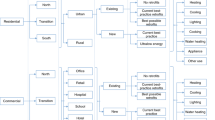Abstract
This paper outlines the energy consumption and greenhouse gas emission trends in the residential and commercial sectors in Japan. The results showed that the increase in residential energy consumption in Japan is mainly caused by the widespread use of heating equipment, hot water supply apparatus, and other household electrical appliances. On the other hand, it was indicated that the increase in commercial energy use is mainly due to the increase of the floor area of buildings, particularly hotels, hospitals, and department stores. The paper also describes political measures to promote energy conservation, including the building energy conservation standard, Comprehensive Assessment System for Building Environmental Efficiency, top runner programs, financial incentives, and the dissemination of the Cool Biz concept. Finally, the projections of CO2 emissions until 2050 are presented.














Similar content being viewed by others
Notes
In May 2007, the Fourth Assessment Report (AR4) of the Intergovernmental Panel on Climate Change (IPCC)/WG3 was approved in Bangkok, Thailand. Two of the current authors have participated in the working group for Chapter 6 Residential and Commercial Buildings of AR4, IPCC/WG3. In relation to this work, the Building Alleviation Policy Review Committee (Chairperson: Prof. Shuzo Murakami, Building Research Institute of Japan) was established in November 2004 with the cooperation of the Institute for Building Environment and Energy Conservation (IBEC), and the Global Industrial and Social Progress Research Institute (GISPRI) under the sponsorship of the Ministry of Land, Infrastructure, Transport and Tourism of Japan and the Ministry of Economy, Trade and Industry of Japan. In this meeting, up-to-date information of energy consumption and mitigation technologies in Japan was prepared and compiled. This report, entitled “Energy Consumption, Efficiency, Conservation, and Greenhouse Gas Mitigation in Japan’s Building Sector,” was later published by Lawrence Berkeley National Laboratory in association with Dr. Mark Levine in December 2006 (Murakami et al. 2006).
References
Building-Energy Manager’s Association of Japan (2002). Annual Report.
Cabinet Office (2004). Monthly Consumer Confidence Survey.
Chiba, T., Yoshino, H., Hasegawa, K., & Mitamura, T. (2004). Energy conservation from a “low-impact” life style in a residential building, Part 2: Calculation for detached house in Sendai city. Summaries of Technical Papers of Annual Meeting. Architectural Institute of Japan, Environmental Engineering II, pp. 297–298 (in Japanese).
Japan’s “Top Runner” Standard. (2008). Developing the world’s best energy-efficient appliances, revised edition, Jan 2008. http://www.eccj.or.jp/top_runner/index_contents_e.html.
Hasegawa, Y., & Inoue, T. (2004). Household energy consumption reported on a national questionnaire. Study of the influence of household characteristics on energy consumption, Part 1.. J. Environ. Eng. Architectural Institute of Japan, 583, 23–28 (in Japanese).
Ikaga, T., Murakami, S., Kato, S., & Shiraishi, Y. (2000). Estimation of CO2 emissions associated with building construction and operation through 2050 in Japan: Life-cycle assessment of buildings and cities. J. Archit. Plan. Environ. Eng. Architectural Institute of Japan, 535, 53–58 (in Japanese).
Institute of Building Environment and Energy Conservation (IBEC) Japan (2004). Guidelines for Designing Energy-Efficient Buildings (in Japanese).
Institute of Building Environment and Energy Conservation (IBEC) Japan (2008). http://www.ibec.or.jp/CASBEE/english/index.htm.
Iwafune, Y., Yokoo, M., Nakagami, H., & Aida, M. (2006). Study on residential energy consumption in the world (1. western countries). The 22nd Conference on Energy, Economy, and Environment, pp. 159–162.
Japan Heat Service Utilities Association. (2005). The heat service utilities handbook (in Japanese)
Jyukankyo Research Institute. (2004). Residential energy statistics year book (in Japanese).
Ministry of Economy, Trade and Industry of Japan (METI). (2006). Outline of energy conservation measures: Expectation of ESCO business. 6th Conference of Japan Association of Energy Service Companies.
Ministry of Environment, Government of Japan. (2006). Press release in 10/11/2006. http://www.env.go.jp/press/press.php?serial=7690 (in Japanese).
Ministry of Environment, Government of Japan. (2008). Collection of environmental statistic. http://www.env.go.jp/doc/toukei/contents/index.html (in Japanese).
Ministry of Internal Affairs and Communications (MIC). (2005). National survey of family income and expenditure.
Ministry of Land, Infrastructure, Transport and Tourism (MLIT). (2006b). Statistics of housing performance assessment labeling.
Ministry of Land, Infrastructure, Transport and Tourism (MLIT). (2008a). Statistics of construction.
Murakami, S. (2006). Building energy conservation in Japan: The potential to raise energy efficiency, energy efficiency in buildings. IEA, Paris. http://www.iea.org/Textbase/work/workshopdetail.asp?WS_ID=279.
Murakami, S., Levine, M., Yoshino, H., Inoue, T., Ikaga, T., Shimoda, Y., Miura, S., Sera, T., Nishio, M., Sakamoto, Y., Fujisaki, W., (2006). Energy consumption, efficiency, conservation, and greenhouse gas mitigation in Japan’s building sector. Lawrence Berkeley National Laboratory in Collaboration with Japanese institutions.
Nakagami, H., & Murakoshi, C., et al. (2002). The trend and subject of ESCO business in Japan. Proceedings of the Improving Electricity Efficiency in Commercial Buildings. 2nd Conference on Electricity Efficiency in Commercial Buildings (IEECB2002), 27–31 May 2002, Nice, France.
NEDO (New Energy and Industrial Technology Development Organization). (2006). http://www.nedo.go.jp/english/activities/2_sinenergy/3/p99045e.html.
The Energy Conservation Center Japan. (2005). Top runner program, developing the world’s best energy-efficient appliances. http://www.eccj.or.jp/top_runner/index.html.
The Energy Conservation Center Japan. (2006a). Energy efficient products’ catalog. http://www.eccj.or.jp/catalog/2006oair/71-4.html (in Japanese).
The Energy Conservation Center Japan (2006b). Cases of the buildings with ESCO: 2005–2006 (in Japanese).
The Institute in Energy Economics of Japan. (2006). EDMC handbook of energy & economic statistics in Japan.
Yoshino, H. (1997). Indoor thermal problems of residential buildings in cold and snowy regions of Japan. In M. Izumi, T. Nakamura, & R. Sack (Eds.), Snow engineering: Recent advances. Rotterdam: Balkema. ISBN 9054108657.
Yoshino, H., Xie, J., Hasegawa, K., Mitamura, T., Genjo, K., Yuasa, K., Chiba, T., Sugawara, H. (2005). Energy saving effect of low-impact lifestyle for residential buildings in Tohoku District, Journal of Technology and Design, Architectural Institute of Japan, 22, 325–328 (in Japanese).
Yuasa, K., Yoo, J. H., Yoshino, H., & Hasegawa, K. (2005). Effect of a low-impact life style on energy conservation in a residential building. Proceedings of the 21st Conference on Energy, Economy, and Environment, pp. 31–33 (in Japanese).
Author information
Authors and Affiliations
Corresponding author
Rights and permissions
About this article
Cite this article
Murakami, S., Levine, M.D., Yoshino, H. et al. Overview of energy consumption and GHG mitigation technologies in the building sector of Japan. Energy Efficiency 2, 179–194 (2009). https://doi.org/10.1007/s12053-008-9040-8
Received:
Accepted:
Published:
Issue Date:
DOI: https://doi.org/10.1007/s12053-008-9040-8




